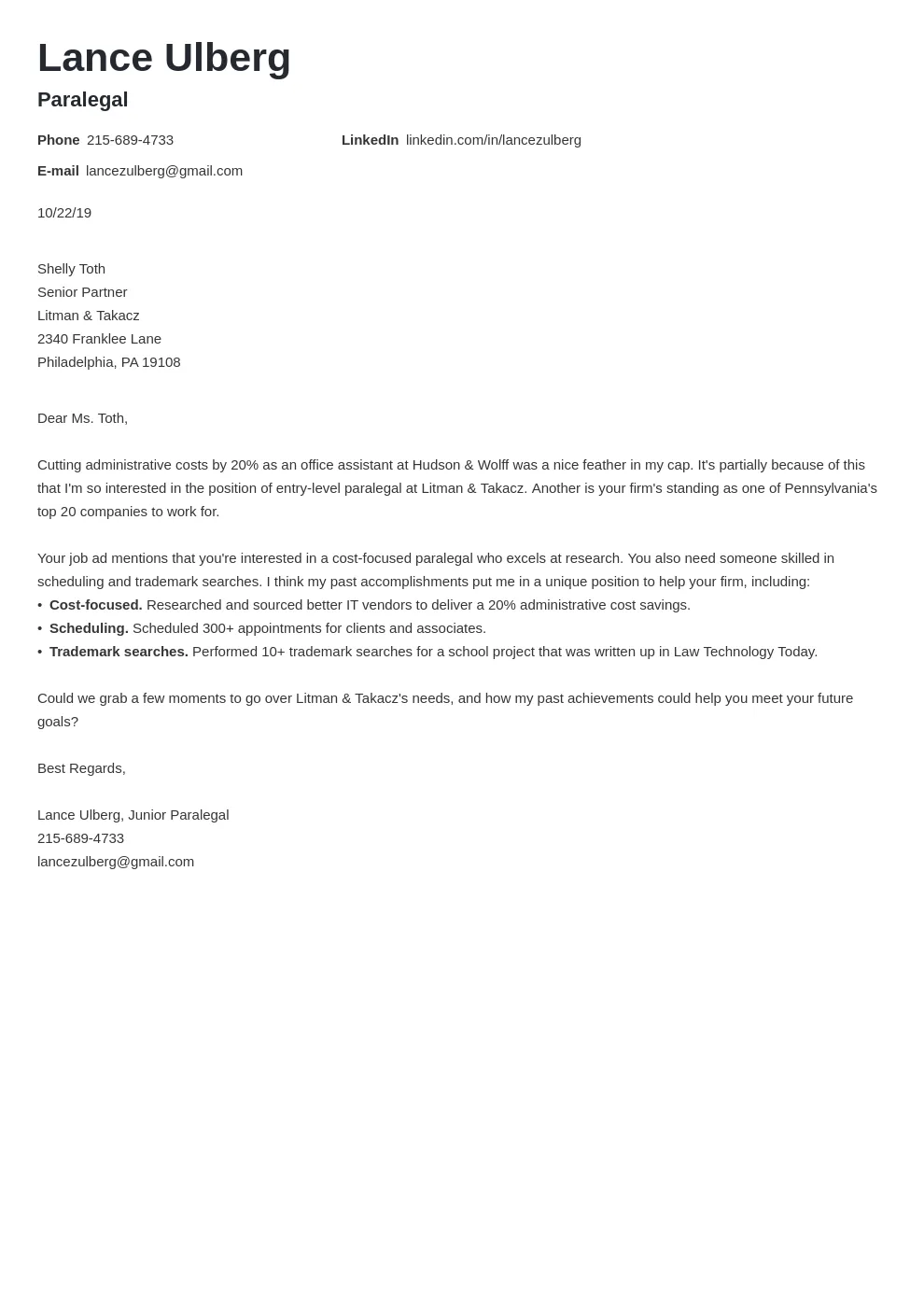What is a Paralegal Cover Letter
A paralegal cover letter is a crucial document that accompanies your resume when applying for a paralegal position. It serves as your first introduction to a potential employer and provides an opportunity to showcase your skills, experience, and personality. Unlike a resume, which offers a brief overview of your qualifications, a cover letter allows you to elaborate on your accomplishments, explain your motivations, and demonstrate why you are the ideal candidate for the role. A well-crafted cover letter can significantly increase your chances of securing an interview and ultimately landing the job. It should be customized for each position you apply for, highlighting the specific skills and experiences that align with the employer’s requirements. Remember to always proofread your cover letter carefully for any grammatical errors or typos. This shows professionalism and attention to detail, both important traits for paralegals. Using cover letter samples as a guide can help ensure you address all the key elements effectively.
Key Elements of a Strong Paralegal Cover Letter
Several essential elements must be included in your paralegal cover letter to make it compelling and effective. These elements work together to create a professional and engaging document that captures the hiring manager’s attention. Each component serves a specific purpose, contributing to a complete and persuasive presentation of your qualifications. From the initial contact information to the final closing, every detail matters when making a strong first impression. By adhering to best practices and ensuring each element is carefully considered, you can create a cover letter that stands out and successfully promotes your candidacy. A well-structured cover letter highlights your most relevant skills and experience while also reflecting your professionalism and attention to detail, vital attributes for any successful paralegal.
Your Contact Information
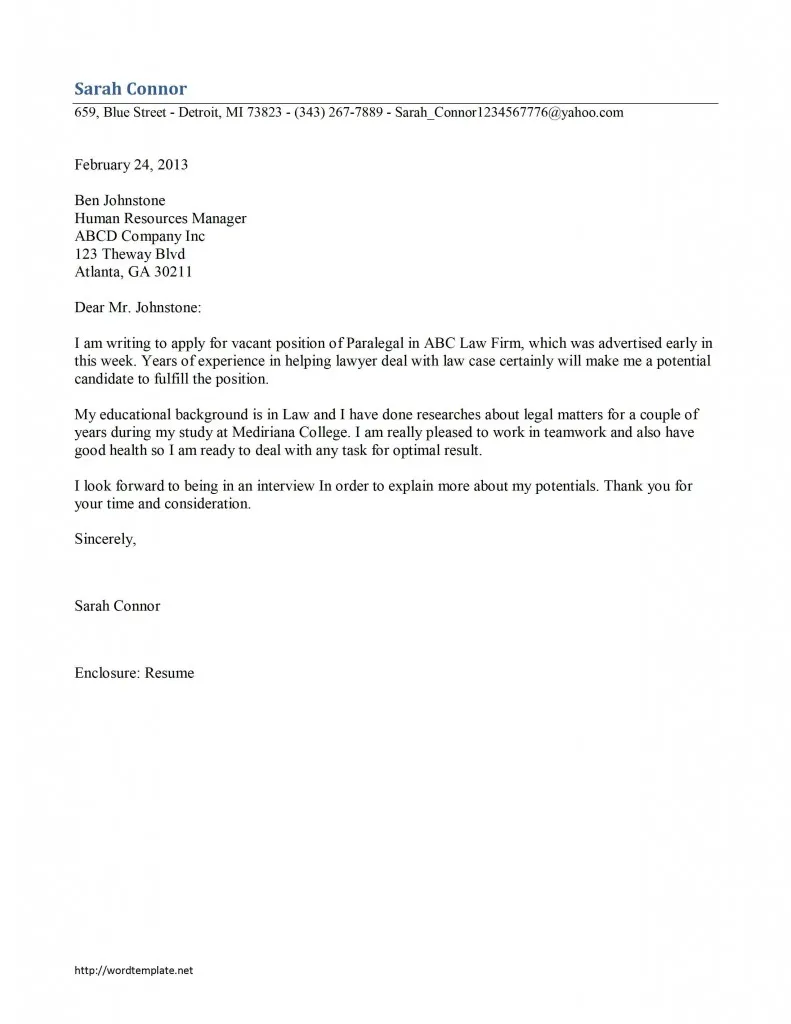
At the top of your cover letter, provide your full name, phone number, email address, and optionally, your LinkedIn profile URL. Ensure this information is accurate and up-to-date. This allows the hiring manager to easily reach you if they are interested in your application. Presenting this information clearly and concisely at the beginning ensures easy access to your contact details. Double-check all information for accuracy to prevent any miscommunication or delays in the hiring process. Make sure your email address sounds professional. It’s advisable to use an email address that contains your name rather than a nickname or something overly casual. This enhances your credibility and shows you pay attention to detail, which is crucial in the legal field.
Date
Following your contact information, include the current date. This helps the recipient understand when the letter was written. The date should be formatted correctly according to standard business letter conventions. It ensures that your application appears current and well-organized. The date’s formatting should be consistent with other elements in your cover letter, such as the recipient’s information and salutation. A correctly dated letter demonstrates professionalism and attention to detail. It allows the reader to quickly understand when the application was submitted, providing context for the hiring process. Including the date shows that you are organized and punctual, characteristics that hiring managers look for in potential paralegals.
Recipient’s Information
Address your cover letter to the hiring manager by name, if possible. Research the firm or organization to find the name of the hiring manager or the person responsible for reviewing applications. If you can’t find a specific name, use a professional title, such as “Hiring Manager” or “Recruiting Team.” Using the correct name and title personalizes the letter and shows that you have taken the time to research the company. Addressing the recipient directly shows that you pay attention to detail and are genuinely interested in the position. If a specific name is unavailable, make sure the generic title is accurate and fits the organization’s structure. This personalization helps your cover letter to stand out among numerous applications.
Professional Salutation
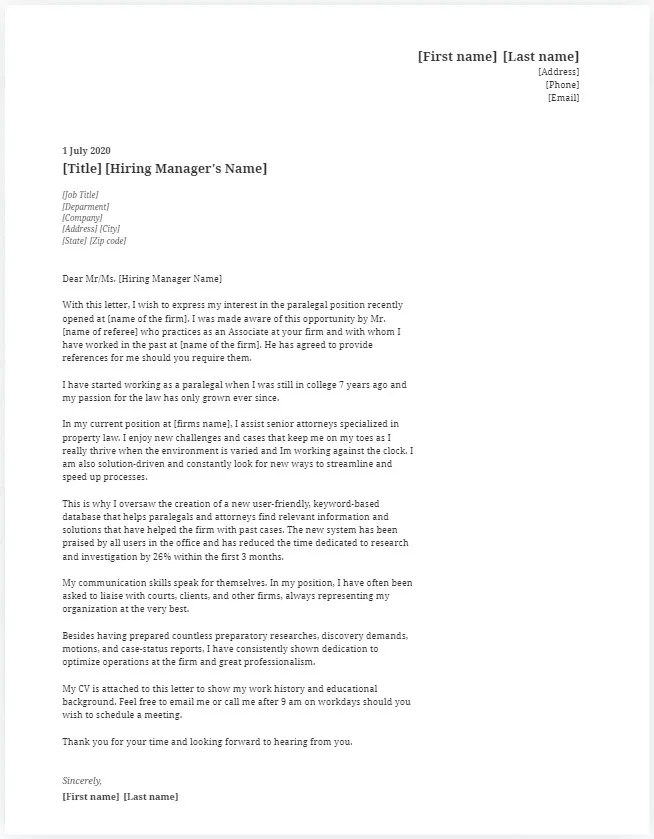
Use a professional salutation, such as “Dear Mr. / Ms. / Mx. [Last Name],” to begin your letter. If you don’t know the recipient’s name, use “Dear Hiring Manager” or “Dear Recruiting Team.” Avoid overly casual greetings, such as “Hi” or “Hello.” A professional salutation sets a formal and respectful tone from the outset. It signals your attention to detail and respect for the recipient. Ensure the salutation matches the information you’ve gathered about the recipient, and double-check the spelling of their name. If the hiring manager’s name is unknown, using a general greeting is acceptable, but ensure it is also professional. This approach maintains the right level of professionalism. This makes your letter more engaging and increases the chances of a positive response.
Writing an Effective Introduction
The introduction of your cover letter is crucial as it grabs the reader’s attention and sets the tone for the rest of the document. Briefly state the position you are applying for and where you found the job posting. Immediately highlight your most relevant skill or experience to capture their interest. Keep the introduction concise and focused, typically no more than three to four sentences. Clearly state the specific position you are applying for, to avoid any confusion. Mentioning where you saw the job posting can show your attentiveness and diligence in finding opportunities. The goal is to create an immediate connection with the hiring manager and encourage them to read the entire letter.
Highlighting Your Paralegal Skills and Experience
The body of your cover letter is where you demonstrate your qualifications and how you match the requirements of the job. This is where you make your case for why you’re the best candidate. Highlight your relevant skills and experience, tailoring your response to the specific job description. Use specific examples to illustrate your accomplishments and how you have contributed to previous employers. Support your claims with evidence, such as quantifiable results or successful projects. This is the core of your cover letter, where you convince the hiring manager that you have the necessary expertise. Make it clear how your abilities and experiences align with the company’s needs. This shows your suitability and adds value to your application. The examples provide solid proof of your capabilities.
Showcasing Legal Knowledge
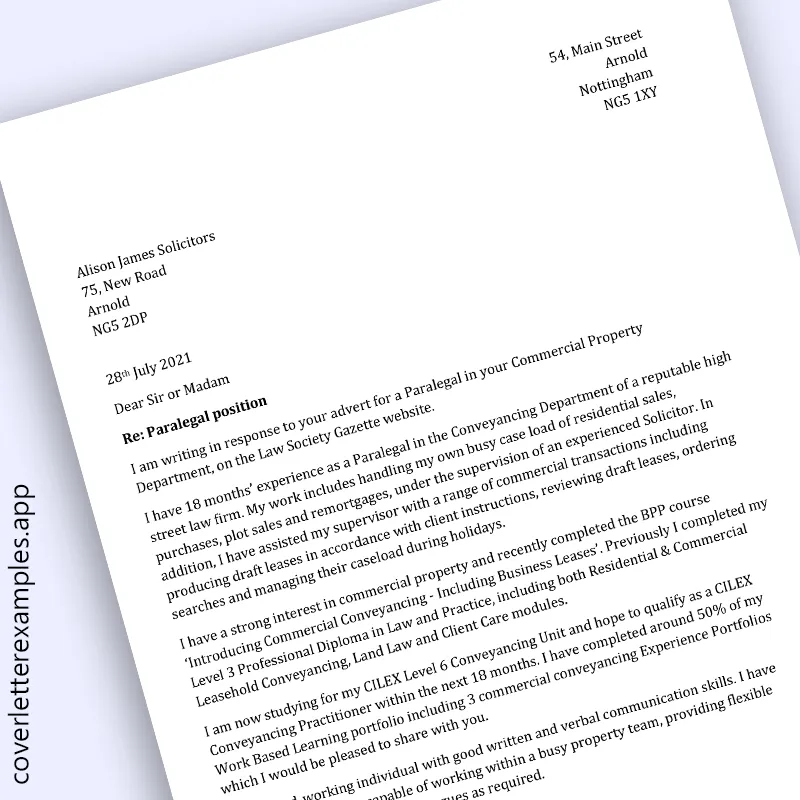
Emphasize your legal knowledge and understanding of legal procedures. Mention specific areas of law you are familiar with, such as litigation, real estate, or corporate law. Provide examples of how you have applied this knowledge in previous roles. This demonstrates your technical expertise and ability to perform the duties required of a paralegal. Tailor your examples to match the specific requirements listed in the job description. Highlight any certifications or specializations that demonstrate your expertise. This shows you possess the legal skills needed for the position, and makes you a more promising candidate. Your knowledge can make you more desirable for the role.
Detailing Relevant Experience
Provide specific details about your relevant experience, including the name of your previous employers, your job titles, and the dates of employment. Describe your responsibilities and key achievements in each role. Focus on the duties and projects that align with the requirements of the paralegal position you are applying for. Quantify your accomplishments whenever possible to demonstrate the impact you have made. Use action verbs to start your sentences, which adds to the impact of your accomplishments. Include any specialized experience or expertise that aligns with the job requirements. This helps the hiring manager understand the breadth and depth of your capabilities. The detailed experience section provides a clear picture of your career trajectory and accomplishments, making you a stronger candidate.
Quantifying Accomplishments
Whenever possible, quantify your accomplishments with numbers and data. Use specific metrics to illustrate the impact you have made in previous roles. For example, state the number of cases you have managed, the percentage by which you improved efficiency, or the amount of money you saved the firm. This provides concrete evidence of your skills and abilities, making your cover letter more impactful. Quantifying your achievements shows your contributions were real and measurable. Providing numbers demonstrates that you are results-oriented and capable of delivering tangible benefits to the new employer. The metrics provide solid evidence that supports your claims and strengthens the message of your application.
Expressing Your Enthusiasm
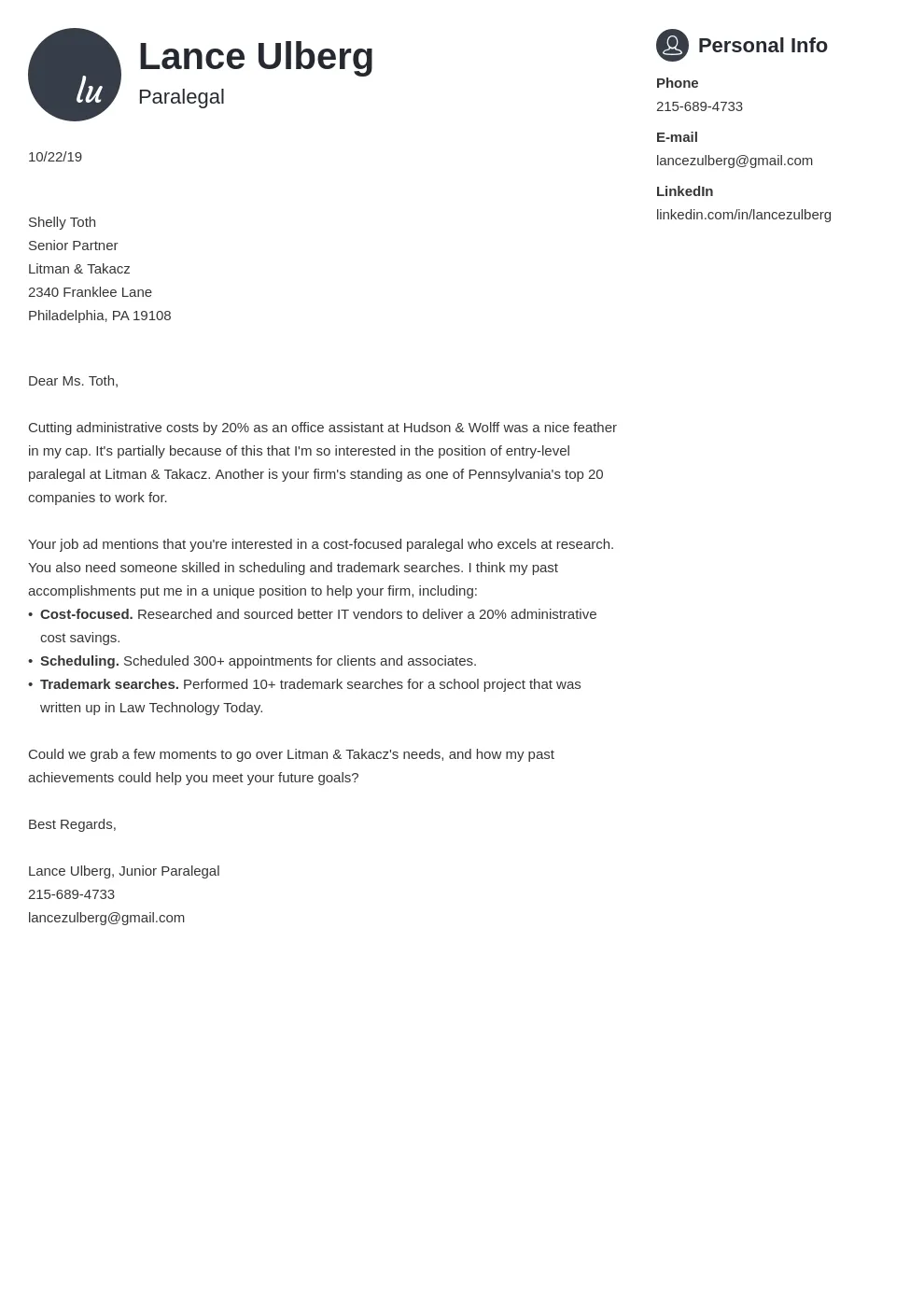
Demonstrate your enthusiasm for the position and the firm. Explain why you are interested in the specific role and what motivates you to apply. This can include the company’s mission, values, or the opportunity for professional growth. Your genuine interest in the role can make you stand out from other applicants. Show that you have researched the firm and understand its work. Personalize your letter by tailoring your statements to the company’s specific values and the job description. Your enthusiasm can make a significant difference and show you are excited to work for them. Highlighting your understanding shows that you have done your research and are genuinely interested in the opportunity.
Explaining Why You’re a Good Fit
Clearly explain why you believe you are a good fit for the position. Outline how your skills, experience, and personality align with the requirements and the culture of the firm. Provide specific examples that showcase how your experience aligns with the job duties described in the job description. Address any gaps in your experience or explain why your skills can compensate for them. Clearly articulate how you can contribute to the firm’s success. Demonstrate that you possess the qualities and abilities the hiring manager is seeking. Your explanation will help the hiring manager see your potential contributions, solidifying your fit for the role. Showing how your skills and experience align will create a clear connection between you and the needs of the position.
Tailoring Your Letter to the Job
Tailor your cover letter to each specific job you apply for. Review the job description carefully and identify the key skills and requirements. Customize your letter to highlight how your skills and experience match those requirements. Use the same keywords and phrases from the job description to demonstrate that you meet the job’s criteria. This helps the hiring manager to quickly see that you meet the requirements. Customizing your cover letter shows that you are serious about the position and have put thought and effort into your application. A generic cover letter won’t make you stand out; tailoring makes you the right candidate. Tailoring demonstrates your attention to detail and initiative. It is a crucial step in presenting your qualifications effectively.
Demonstrating Your Understanding of the Firm
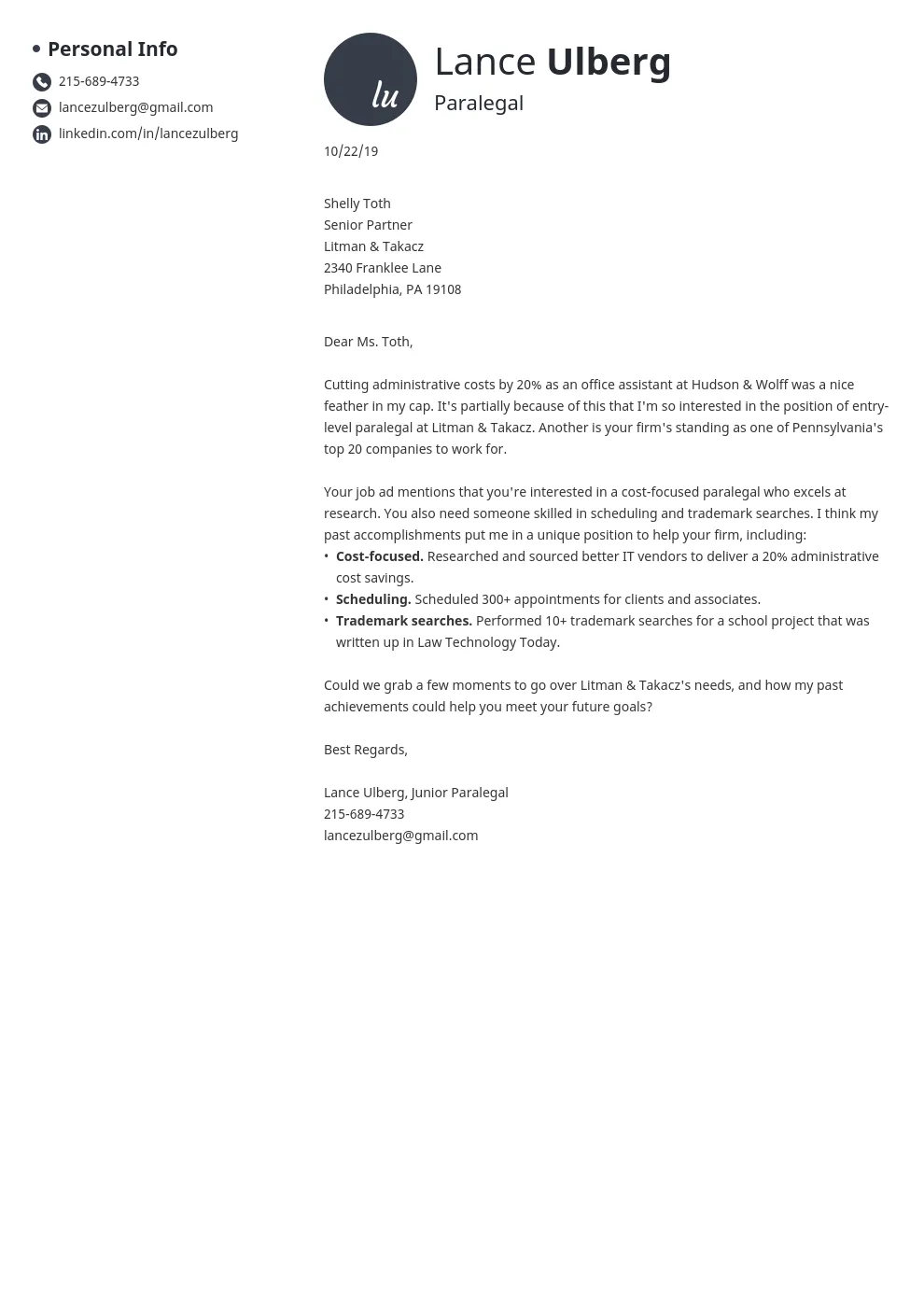
Show that you have researched the firm and understand its work, values, and mission. Mention specific projects, clients, or cases that resonate with you. This demonstrates your genuine interest and your understanding of the firm’s operations. Refer to the firm’s website, social media, or news articles to get a better understanding of its culture and recent activities. Highlight how your values and goals align with the firm’s. Demonstrating your understanding shows that you have taken the initiative to learn about the organization and are not just applying to any job. This understanding will make your application more personalized and shows you are genuinely interested in working with them. Doing your research is essential.
Crafting a Compelling Closing
The closing of your cover letter should summarize your interest and make a call to action. You should reinforce your enthusiasm and make it easy for the hiring manager to take the next step. This leaves a lasting impression. Keep your closing concise and direct, reinforcing your key qualifications and reiterate your interest. This highlights your most significant qualifications one last time. Your closing can be the final push needed to get you an interview. Keep it positive and engaging to conclude your letter effectively.
Thanking the Reader
Thank the reader for their time and consideration. Express your appreciation for the opportunity to apply and for their review of your application. This shows respect and professionalism. This simple act of courtesy is appropriate for business correspondence. Thanking the reader is a sign of respect, and it can help leave a positive final impression. Expressing gratitude shows that you value the opportunity. It is a small but significant detail in a professional setting. This leaves a positive lasting impression and is considered standard practice in professional communication.
Reiterating Your Interest
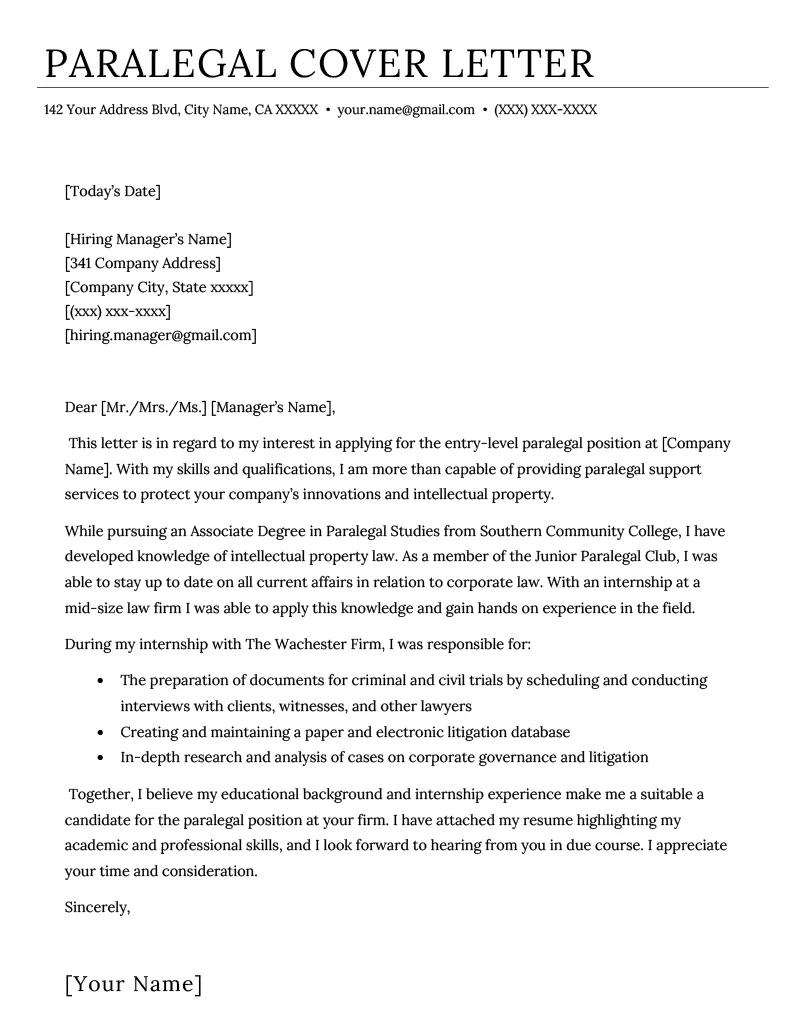
Reiterate your interest in the position and the firm. Reaffirm your enthusiasm and your desire to contribute to the team. Briefly summarize your key qualifications and why you believe you are a good fit. This reinforces your qualifications and your dedication. Reinforcing your interest underscores your focus on the opportunity and reminds the hiring manager of your key qualifications. This gives them one last reminder of your strongest selling points. Expressing your enthusiasm reinforces your desire and makes your application memorable. Your reiterated interest adds to the overall impact of your letter.
Call to Action
Include a clear call to action, such as requesting an interview or inviting the hiring manager to contact you. Provide your contact information again, just in case it is missed. Make it easy for the hiring manager to take the next step. A clear call to action encourages the hiring manager to contact you. Make sure your contact information is readily accessible. This gives the hiring manager clear instruction on what to do next. This is a crucial part of the closing, as it guides the hiring manager toward the next steps. The call to action is your final invitation to the hiring manager.
Formatting and Proofreading Your Cover Letter
Proper formatting and careful proofreading are essential for a professional cover letter. Poorly formatted documents and errors reflect negatively on your attention to detail. These components will make a big difference in how your application is perceived. Ensure your letter is clear, easy to read, and error-free. Formatting and proofreading are critical for making a positive first impression. They communicate your professionalism and attention to detail.
Choosing the Right Font and Format
Choose a professional font, such as Times New Roman, Arial, or Calibri, in a readable size (11-12 points). Use standard business letter format, with a clear and consistent layout. Maintain consistent formatting throughout the document, including margins, spacing, and alignment. Use a font that’s easy to read, and use standard formats to look professional. A well-formatted cover letter demonstrates that you pay attention to detail. Make sure your formatting is neat and easy to read. Ensure the overall look is professional.
Proofreading for Errors
Proofread your cover letter carefully for any spelling, grammar, and punctuation errors. Check for typos, incorrect word usage, and sentence structure. Read your letter aloud to catch any awkward phrasing or errors. Ask a friend or family member to review your letter as a second set of eyes. Proofreading ensures your letter is polished and error-free. A polished letter shows you are organized and detail-oriented, which are essential traits for a paralegal. This simple step can greatly improve your chances of success. Proper proofreading is vital, so do not rush this step.
Common Mistakes to Avoid
There are several common mistakes that can undermine your cover letter. Being aware of these mistakes will help you avoid them and write a more effective application. Avoiding these pitfalls ensures your cover letter is as strong as possible. Addressing and correcting these errors significantly improves the chances of a positive outcome. Avoiding these will enhance the overall impression you make on the reader.
Using Generic Language
Avoid using generic, cookie-cutter language that could apply to any job. Customize your letter for the specific position and firm, and use specific examples to showcase your skills and experience. Generic language makes your letter sound unoriginal. Tailoring your language to the specific job makes you stand out. Generic statements don’t show your genuine interest and suitability. Using specific and tailored language gives more weight to your application. Customize your application for maximum impact.
Focusing on Yourself Too Much
While highlighting your skills and experience is important, avoid making the letter all about yourself. Focus on how you can contribute to the firm and meet its needs. Show how your skills can benefit the employer. The hiring manager wants to know how you can help them. Emphasize your ability to help them achieve their goals. Demonstrate how you will be of value. Show that you understand the needs and focus on providing solutions.
Failing to Proofread
Failing to proofread your cover letter is a critical mistake. Proofreading ensures your letter is polished and error-free. Always review your letter carefully for any spelling, grammar, or punctuation errors. Ask someone else to review it as well. A simple mistake can diminish your credibility. Always proofread to demonstrate attention to detail and professionalism. Failing to proofread can make you look careless. Thorough proofreading is a small step with big rewards.
Paralegal Cover Letter Samples for Different Situations
Different paralegal roles and situations require different approaches to your cover letter. These tailored examples are a great resource for helping you create the perfect cover letter. Adapting to these situations can significantly increase your chances of success. Tailoring your approach shows initiative and attention to the specific requirements of the job. Adapting to the unique needs of different paralegal positions will help you to showcase your skills effectively. Each position will require certain adjustments based on the unique requirements of the job and the employer.
Entry-Level Paralegal Cover Letter
An entry-level cover letter should emphasize your education, skills, and any relevant experience, such as internships or volunteer work. Highlight your eagerness to learn and contribute to the firm. Emphasize your strong research, writing, and organizational skills, focusing on the skills that transfer to a paralegal role. Even without extensive experience, you can impress by demonstrating your eagerness to start your career. Focus on the knowledge you have, as this is your primary asset. Showcase your potential and enthusiasm. Highlight your academic achievements and soft skills that align with the paralegal role.
Experienced Paralegal Cover Letter
An experienced paralegal cover letter should focus on your accomplishments and quantifiable results. Provide details on your successes in past roles, showcasing your expertise and contributions. Highlight your proficiency in specialized areas of law or specific legal software. Emphasize your ability to handle complex cases and your leadership skills. Demonstrate your ability to contribute to a team and achieve results. Quantify your contributions wherever possible. Provide examples of your success in previous positions to show the scope of your capabilities. Focus on your success and the experience to underscore your value to the firm.
Paralegal Cover Letter for Specific Practice Areas
Tailor your cover letter to the specific practice area for which you are applying. Research the firm’s practice area and customize your letter to match. Highlight your relevant experience and knowledge. Use keywords from the job description to show you have the skills the position requires. Provide specific examples from your past roles that demonstrate expertise. Tailor your letter to the practice area to showcase your expertise in a precise field. This shows your deep understanding and provides maximum impact. Adapt to the needs of the practice area.
Conclusion
A well-crafted cover letter is essential for making a strong impression and securing a paralegal position. By following the guidelines and tips in this guide, you can create a compelling cover letter that showcases your skills, experience, and enthusiasm. Remember to tailor your letter to each specific job, proofread carefully, and present yourself in a professional and engaging manner. By consistently applying these principles, you’ll significantly increase your chances of success in your job search. Always use cover letter samples as a guide. A well-crafted cover letter will help you get hired.
